#isabella i of castile
Explore tagged Tumblr posts
Text


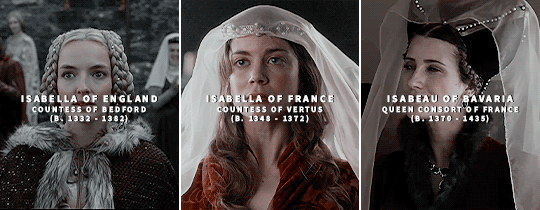
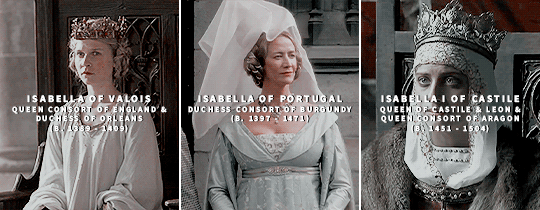


↳ Historical Ladies Name: Isabella/Isabelle
#isabella of gloucester#isabella of angouleme#isabella of england#isabella of aragon#isabella of france#isabella of valois#isabeau of bavaria#isabella of portugal#isabella i of castile#isabel neville#isabella d'este#isabella of austria#isabella of parma#historicalnames*#historyedit#my gifs#creations*
421 notes
·
View notes
Text
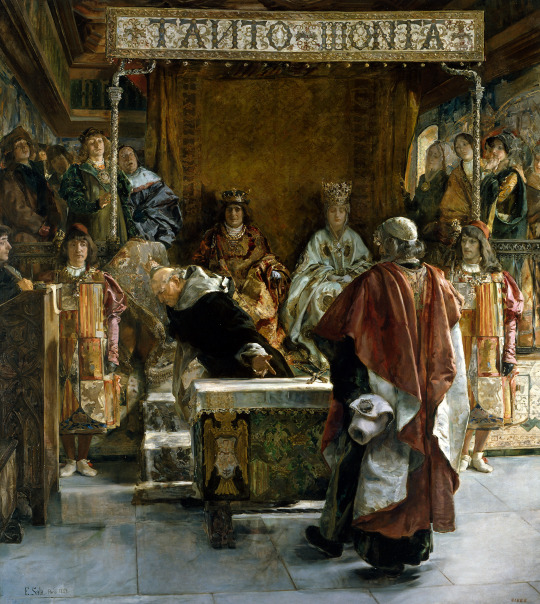
Emilio Sala y Francés (Spanish, 1850-1910) Expulsión de los judíos de España (año de 1492), 1889 Museo Nacional del Prado
#Emilio Sala y Francés#Emilio Sala#1800s#expulsion de los judios de espana#world history#expulsion of jewish people from spain#art#fine art#european art#classical art#europe#european#fine arts#oil painting#europa#mediterranean#Isabella I of Castile#king aragon#ferdinand ii of aragon#queen isabel#king#queen#spanish king#spanish queen#1400s
66 notes
·
View notes
Text

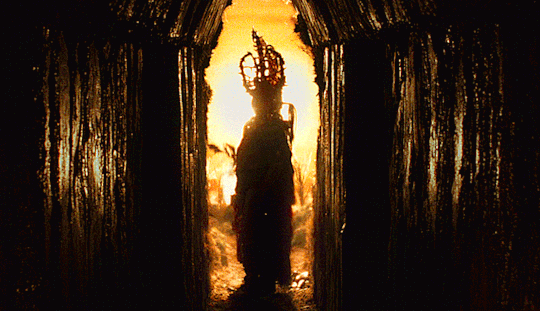



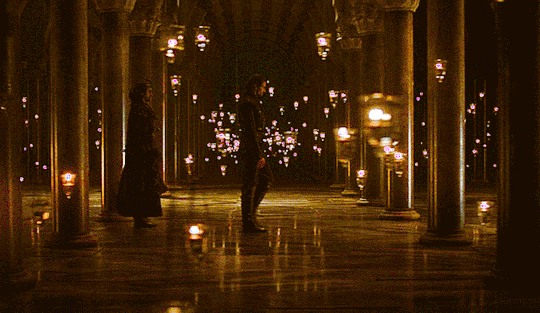

The Fountain scenery
#the fountain#darren aronofsky#hugh jackman#rachel weisz#isabella of castile#spain#alcazar#tree of life#this movie is stunning#aestethic#isabella i of castile
53 notes
·
View notes
Text

“Help! I'm conflicted! Isabella of Castille was a badass and ahead of her time for ruling a country in a man's world and creating the Spain we know today, but she also started the Spanish Inquisition and launched Columbus' expedition to the new world which led to all the slavery and slaughtering.” - Submitted by Anonymous
12 notes
·
View notes
Photo
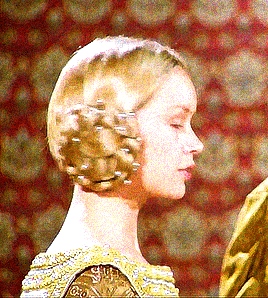

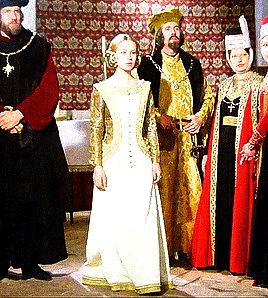
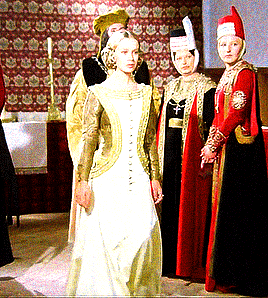
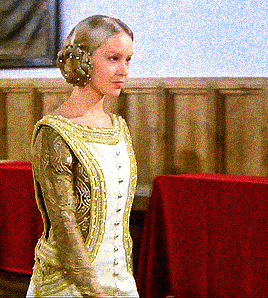
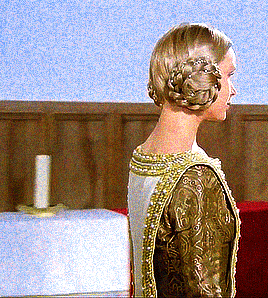
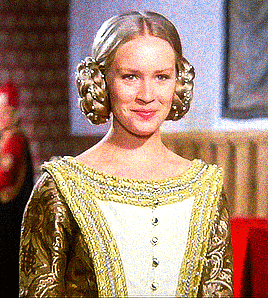
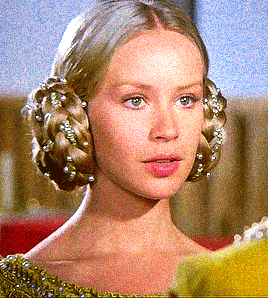
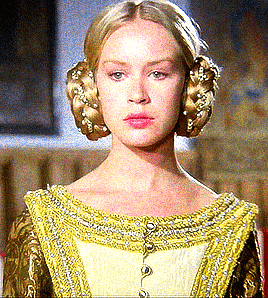
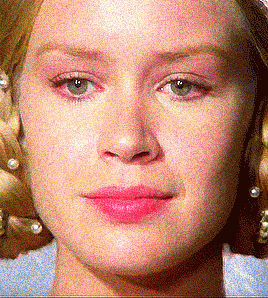
Maribel Martín as Isabella I of Castile in La espada negra (1976)
as requested by @isadomna
226 notes
·
View notes
Text
On 8 August [1483] outlining her hopes for a ‘good and firm’ peace between Castile and England, and offering to form an alliance to attack Louis XI. Isabella gave an unexpectedly personal view of her motives in an oral message delivered by her ambassador, Jofre de Sasiola, duly recorded by Richard’s secretaries. She had been insulted by Edward IV, who had rejected her offer of marriage ‘and taking to his wiff a wedowe of England’. With Edward dead, Isabella finds herself ‘retournyng to her naturall kinde disposicion’. (Horspool
Why does everyone think this means Isabella has always held a grudge against Edward? Their children are engaged!!! I always thought this was Isabella's intentional humor - she faced Richard, who had usurped the throne of Edward's child.
#english history#history#the war of roses#edward iv#richard iii#elizabeth woodville#Isabella I of Castile
8 notes
·
View notes
Text
Random saints by Sittow or Catherine of Aragon's parents?

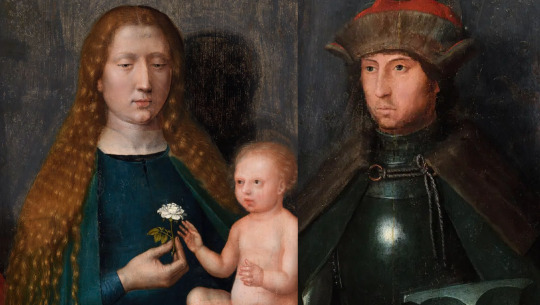
Read further if you wish to know what my theory is.
I first found this photo with mention it is by Sittow and at first I thought it is another portrait of Catherine. But quickly I realised this woman looks older and the features are not exactly the same.
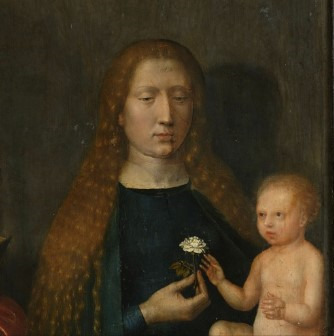
The nose is much narrower. And I started to wonder...we know that Sittow painted at least one portrait of Queen Isabella I of Castile.
And she had such nose. I could exclude possibility some of Catherine's sisters looked like this too, but women in that family tended to be very young-looking for really long.
So the age of sitter already is suggesting that it could be based upon Isabella towards end of her life. And it is also odd for depiction of Virgin Mary to depict woman who is not young...it is point in Isabella's favour.
While many claim Sittow painted Isabella in 1485, he was only born in 1468/1469 and didn't even become indipended master until at least 1488. He is first recorded working in Toledo in 1492. So he'd always be only able to depict Isabella over age of 40. And tbh, if this is her..then she looks great for somebody over 40!
But where is this image? It took me while to track down.
It's detail from wings of theThe Passion Altarpiece (Tallinn), its middle part is from c.1515-1520(with some 17th century additions) by different artist.

But I am not so sure how accurate is the dating of the outer wings by Sittow(1518-1525) which are in very different style, and might have originally belong to different altar middle.

If it is indeed 1518-1525 dating, then imo they are posthumous depictions based upon earlier sketches done from life. Sittow reusing those old sketches, using them as inspiration for his later work.
Link to photos only. Left pannel: https://artsandculture.google.com/asset/the-passion-altarpiece-outer-wing-with-the-virgin-mary-and-apostle-james-the-greater-paintings-of-the-outer-side-of-the-wings-by-michel-sittow-and-his-workshop/BwFnRG1v6gRqmQ
Right pannel: https://arthive.com/artists/75951~Michel_Sittow/works/526786~Saint_Adrian_and_Saint_Anthony
As to where they are located?
-Niguliste Museum(housed in former St. Nicholas' Church), which is part of Art Museum of Estonia(which combines collections from 3 other buildings+ this church). Hence in Tallin, Estonia but be aware there is over 3 km distance in between the church and other buildings.
But if anybody could go there and get us some pictures it'd be great (if it is allowed). Currently Niguliste Museum has exhibition about Sittow:

But back to the pannels. The left one depicts Madonna(Virgin Mary holding baby Jesus) and St. James the Great(apostle and patron saint of Spain:
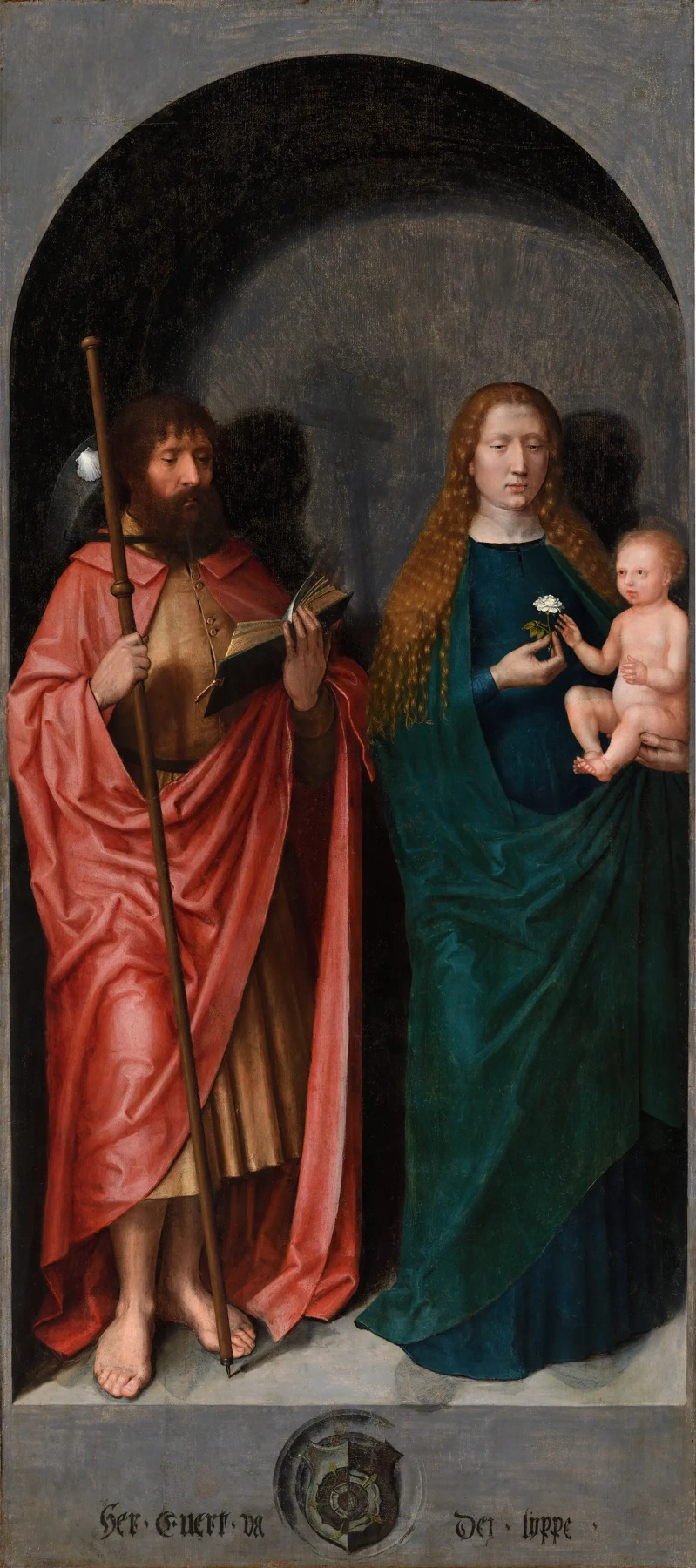
And please note that Tudor rose is combination of red and white rose and not always it was depicted as inner rose white, outer red. Sometimes they were halfed, with inner rose sometiems also switched.

Of course it could be some foreign coat of arms or later alteration.
Right pannel:

Here the coat of arms looks much newer and is probably altered(and if pomegranate turned out to be beneath it, I'd just die...)
The right pannel is depicting two male saints. On right is St Anthony the Great...was father of monasticism(of monastic life)...thus very important saint in christianity...
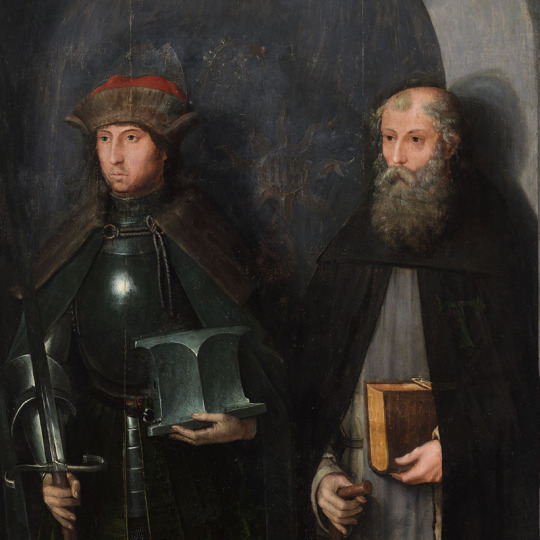
and on left St. Adrian of Nicomedia(2nd most popular military saint after St. George), and imo that's probably King Ferdinand II of Aragon:

It's not great likeness(brows not arched enough, looks bit slimmer, alla of nose not as defined), but overall it's enough of resemblence to not be able to exclude the possibility.
But if this is indeed done years after Sittow was in Spain...and he is reusing his old sketches of catholic monarchs to create this new religious scene(perhaps initially intended for them too, but never made into finished work before), then it is also possible that sketch done in pencil has partially rubbed off...and thus the differences in face of this male.
I think that if this was done while in Spain, such big differences are not very likely to occur. Not that pencil could not rub off, but I think Sittow would have noticed and cared about getting absolutely righ(to please his patrons) and thus would have corrected it.
Ehm, this kitty is supposed to be a lion:
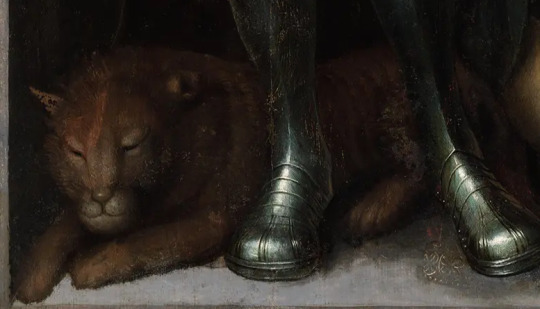
But you must be wondering, if Isabella indeed had this most vivid golden hair colour I always go on and on about, why does she have red hair here?
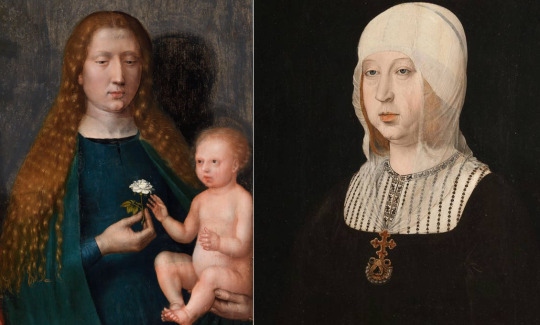
Several options to pick from: Pigments going wrong, Isabella's hair possibly turning to more reddish hues towards end of her life, or simply discoloured pinkish varnish which was very oddly applied...and on baby's skin you can see where somebody applied only one layer and where they went with brush for 2nd time.
If entire pannel has this varnish on, then it'd affect the hair, turning it more red. Why would such varnish not be removed? Sometimes money is tight and museums have multiple paintings to care for and those paintings in fairly good condition have to wait longer.
And sometimes it is not possible to remove discoloured varnish without harming the painting beneath.
Also worth of nothing is that Virgin Mary's dress is typically not teal, but vividly blue, the very best most expensive most vivid blue pigments were very often reserved for depicting the Virgin Mary:

Sometimes due to budget cost cheaper substitues were used, and those tend to fade.
Hence imo the colours originally might have been intended to be more like this(yes, I photoshopped it):

(I didn't change damn thing about male figure, just brightened it. But tbh I played with the woman's dress, skin and hair for while.)
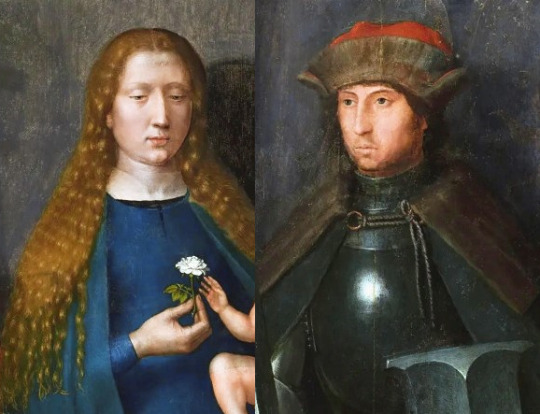
I mean if it looked like this now, fans of catholic monarchs would probably be all over it already.
But people overlook these dark slightly pinkish images located all the way in Estonia, even though it is atributed to Sittow himself!
(I don't mean people in Estonia, I mean people who search for Isabella's lost portrait by Sittow and stubbornly stuck to their favourite which is not even by Sittow!)

I honestly thought that people searching for lost portrait of Isabella by Sittow would have by now checked all his work, to see if perhaps she is there somewhere! Just doesn't look teen or young adult.
So I want you to be aware, if you're on quest of finding Isabella by Sittow's in that portrait with emerald necklace that this is imo the face you're looking for :
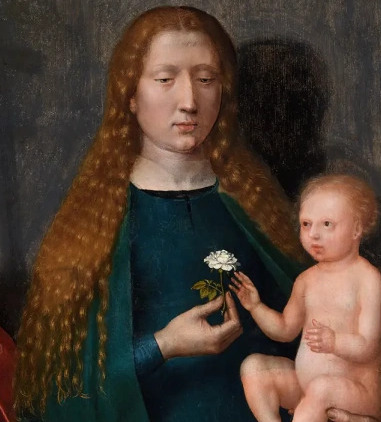
Possibly with hair bit more golden and skin more fair:
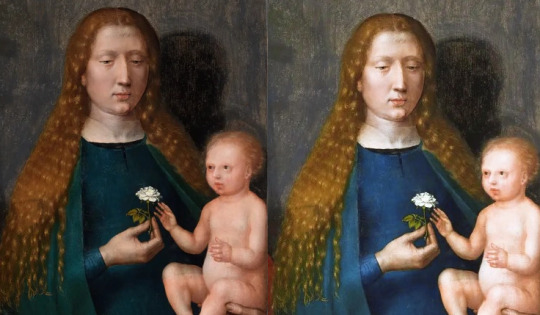
And it doesn't matter she doesn't look 20! She is still very beautiful.
Hence imo, these are Catherine of Aragon's parents, depicted in disguise of saints:

But I think they were likely painted years after Sittow left Spain, and his old sketches of them have been reused to create these pannels. I hope the experts will one day look more into this possibility.
I hope you've enjoyed this, and tell me what you think. Am I onto something or am I chasing shadows?

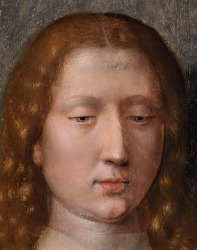
#historical portraits#isabella of castile#ferdinand of aragon#Isabella I of Castile#Ferdinand II of Aragon#sittow
78 notes
·
View notes
Text
Some Spanish authors, however, did credit Mary herself or the couple working together for the restoration of Catholicism. Francisco Garrido de Villena, a caballero of Valencia, wrote that Mary, the “sovereign queen” who was “more than human,” worked “a miracle” in England by restoring the religion that had been “lost to a cursed Lutheran sect.” Bartolomé Carranza, the queen’s confessor, referred to Mary and Philip as the “Catholic Kings who restored the ancient and true religion.” Previously, the title “Catholic Kings” was associated with Isabel of Castile and Ferdinand of Aragon, Mary’s grandparents and Philip’s great-grandparents, who had united the two major kingdoms of Spain through their marriage in 1474 and conquered the Muslim Kingdom of Granada in 1492, thereby concluding the centuries-long Reconquista. Carranza made the connection between Isabel-Ferdinand and Mary-Philip explicit in his preface “to the pious reader” by referring to “the Catholic Kings,” meaning Isabel and Ferdinand, on the first page, then referring to “the Catholic Kings,” meaning Mary and Philip, on the next page, but whereas Isabel and Ferdinand had lived before Martin Luther and thus commanded the Bible to be translated into the vernacular, Mary and Philip removed vernacular Bibles in order to restore Catholicism to England, according to Carranza. For Spaniards, the implication of Carranza’s use of the title was that Mary and Philip were supervising a new reconquest, one that was less militarized if no less religiously contentious than the first. Further, his use of the masculine “kings” to refer to both Mary and Philip suggested an equality between them, just as Isabel and Ferdinand had maintained an equilibrium throughout their marriage.
— A Narrative That Was Not Her Own: Mary I as Mediterranean Queen by Darcy Kern, 2022. In Writing Mary I: History, Historiography, and Fiction, edited by Valerie Schutte and Jessica S. Hower
#historicalquotes#history#tudorerasource#Kern tag#dailytudors#mary i of england#philip ii of spain#marriage#parallels#religion#isabella i of castile#Bartolomé Carranza#ferdinand ii of aragon#*mine#*quotes
50 notes
·
View notes
Text

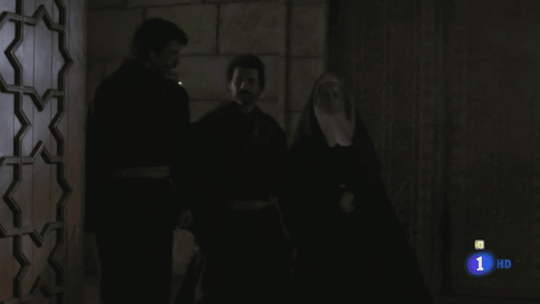
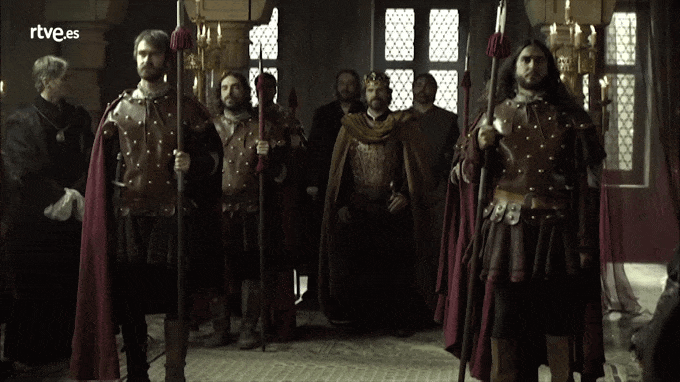

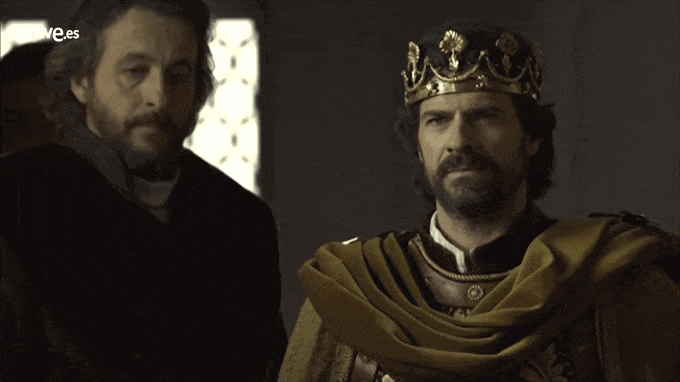
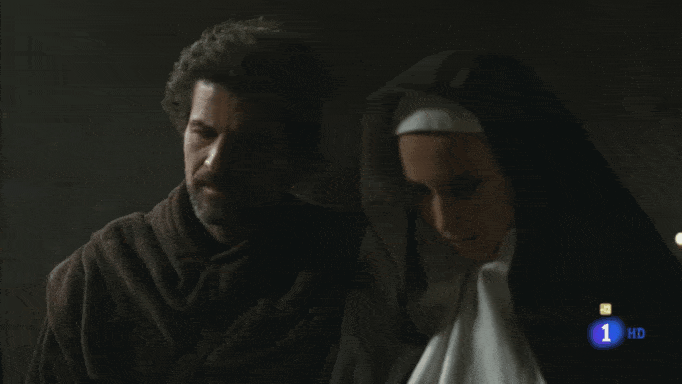

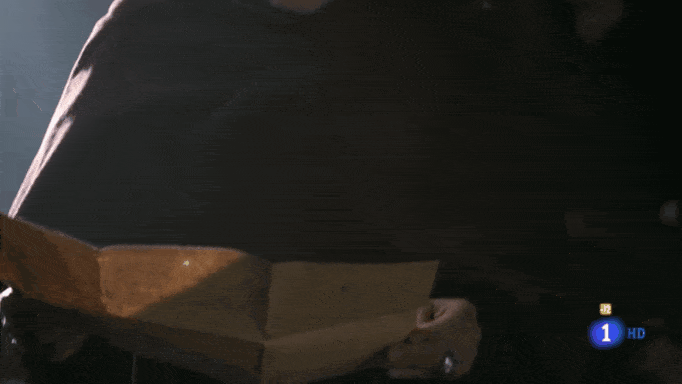
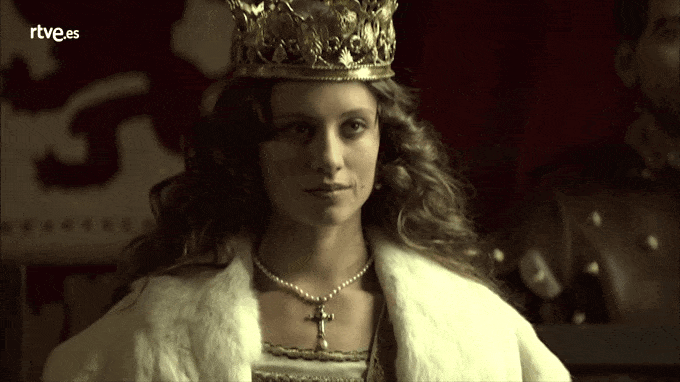

Juraría que la conozco de algo...
Isabel (2012-2014), 2×01 Desencuentros II El Ministerio del tiempo (2015-), 1×04 Una negociación a tiempo
#el ministerio del tiempo#isabel tve#1×04#una negociación a tiempo#2×01#desencuentros#nacho fresneda#aura garrido#rodolfo sancho#michelle jenner#eusebio poncela#ramón madaula#alonso de entrerríos#amelia folch#julián martínez#fernando ii de aragón#ferdinand ii of aragon#isabella i of castile#isabel i de castilla#cardenal cisneros#gonzalo chacón#francisco jiménez de cisneros#emdt#mdt
68 notes
·
View notes
Text

Columbus Before the Queen by Emanuel Leutze, 1843.
#classic art#painting#emanuel leutze#american artist#19th century#romanticism#history#early modern period#spanish history#christopher columbus#isabella i of castile#ferdinand ii of aragon#royal court#people#inside#throne#palatial interior
23 notes
·
View notes
Text
youtube
Isabel I
¿Una mujer reina de Castilla?
A woman queen of Castile?
#isabel#isabel I#medieval#queen#reina#isabella i of castile#isabel de castilla#isabel i de castilla#isabella of castile#youtube#queen of kings#heir#woman#mujer#heredera#Youtube#medieval queen#history#historia#reina medieval
2 notes
·
View notes
Text
I just remembered that there is a comic where Robin ( Dick Grayson) and Wonder Woman travel in time to go to Isabella I of Castille's era:
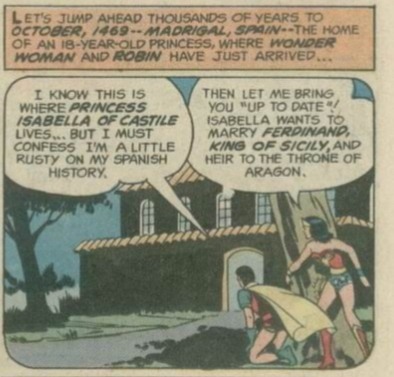
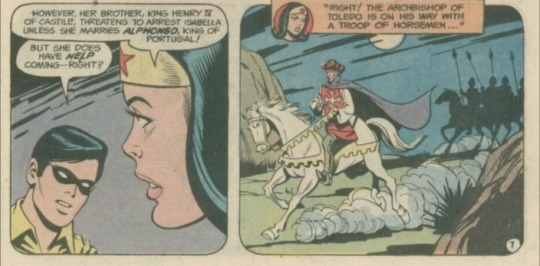
After completing their mission, preventing the time trapper to interfere, Isabella is free to marry Ferdinand:
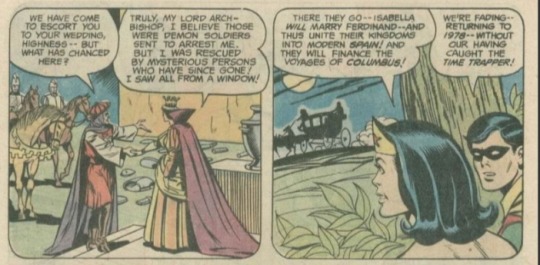
(The Super Friends issue #18)
17 notes
·
View notes
Text
TOMAS DE TORQUEMADA
1420-1498
Spanish friar, mass murderer, who had heretics tortured and burned alive
Tomás de Torquemada was a Spanish inquisitor and a Dominican friar; he became Spain’s first Inquisitor general in 1483. He met the young Princess Isabella I; they both had a strong religious rapport. He served as her regular confessor and advisor and was at her coronation in 1474, and advised her to marry King Ferdinand of Aragon in 1469. The Spanish Inquisition was a group that was created in 1478, to ‘uphold Catholic religious orthodoxy’ with the lands of Castile and Aragon (Kingdom of Spain).
Torquemada was a ruthless madman who persecuted heretics and became known for his use of torture and severe punishments. It is said that he had around 2,000 people killed by burning at the stake. ��
Muslims and Jews in Castile and Aragon had to convert to Catholicism for survival. Torquemada was one of the chief supporters of the Alhambra Decree that expelled the Jews from Castile and Aragon in 1492. Around 40,000 Jews were expelled from Spain and the rest converted to Catholicism so they could remain in Spain, who secretly remained Jewish.
Queen Isabella’s secretary wrote that 2,000 executions took place throughout her reign, which continued after Torquemada died. His health was failing in his final years and Pope Alexander VI appointed four assistants to assist him in the Inquisition. Torquemada retired to the monastery of St. Thomas Aquinas, Avila in 1494 and lived the life of a friar. He died at the monastery in 1498, aged 77, and was interred there. His tomb was ransacked in 1832, his bones were apparently stolen.
#tomasdetorquemada #ferdinandIIofaragon #isabellaIofcastile #atheism #history #truecrime

#tomas de torquemada#tomasdetorquemada#ferdinand ii of aragon#isabella i of castile#atheism#history#true crime
5 notes
·
View notes
Link
Isabella I, also called Isabella the Catholic, was Queen of Castile and León from 1474 until her death in 1504. She was also Queen of Aragon from 1479 until her...
Link: Isabella I of Castile
0 notes
Text
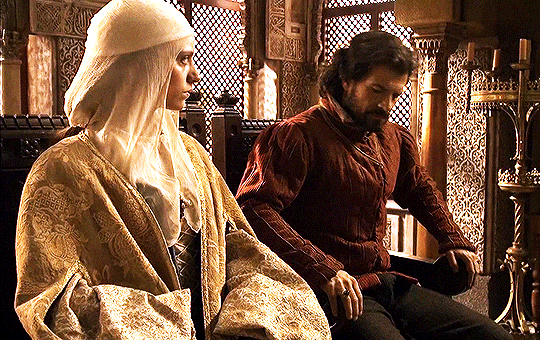




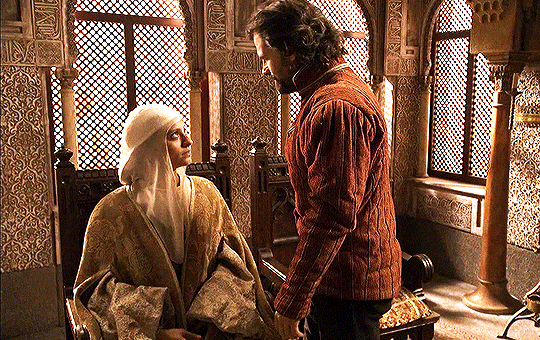
ISABEL TVE 2x06
#perioddramaedit#perioddramasource#weloveperioddrama#isabel tve#2x06#isabella i of castile#ferdinand ii of aragon#michelle jenner#rodolfo sancho
95 notes
·
View notes
Text

absolutely abysmal that it's giving me the assassin's creed wiki over literally anything else
1 note
·
View note